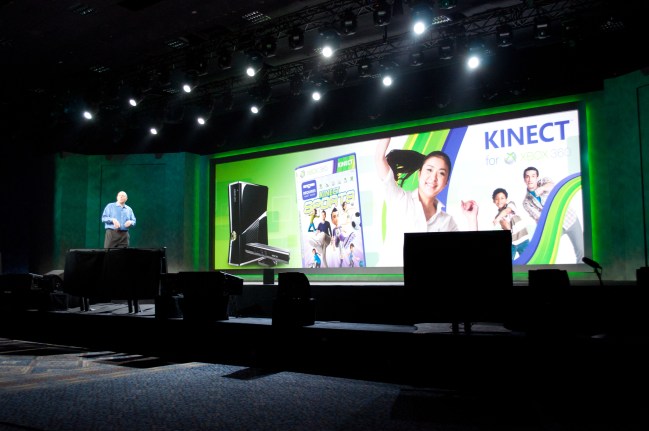
CES is just beginning, and Microsoft was favored to be a high point of the event. Microsoft’s Steve Ballmer gave the opening keynote conference tonight in Las Vegas, summarizing the company’s impressive year as well as what it has to offer in the near future.
Xbox and Kinect updates
As can be expected, Ballmer directed a significant amount of attention to the success (eight million sold in the first two months according to Ballmer) and upcoming developments of Microsoft’s motion-gaming device Kinect. After singing its praises and uttering the “you are the controller” tagline one too many times, Ballmer brought up Microsoft executive Ron Forbes to introduce the next step for the product. This spring, users will be able to use Kinect’s motion detection as well as voice command to control services like Netflix, Hulu Plus, and Xbox Live.
And these weren’t the only updates to Microsoft’s gaming platform, as Forbes also explained bolstered Xbox Live and ESPN capabilities that center on the social element.
While these features are impressive, Ballmer also touched on Avatar Kinect, a facial recognition program coming to Kinect. After getting a glimpse at Intel’s avatar development (which is purely experimental – for now) it failed to impress. The system seems to be primarily used for group chat and social media purposes and left something to be desired.
Windows Phone 7
Microsoft took this chance to remind consumers that the Windows 7 Phone is a viable mobile option. There were no features introduced, save two updates that will add copy and paste and also significantly improve performance while loading or switching applications. These are due in the coming months and will automatically be pushed out to users. The phone will also be available to Sprint and Verizon customers at the beginning of 2011.
PCs and tablets…sort of
Of course, what we’ve all been waiting for is the mythical Microsoft tablet. Analysts have said the company needs a competent device to stay in the game, and it’s half way taking that advice. Ballmer and executive Mike Anguilo acknowledged that consumers want their technology in multiple forms of hardware, and with that in mind are delivering various products, including a fully powered Asus tablet PC with a stylus pen and handwriting recognition capabilities. Anguilo also debuted one product that got an audible reaction from the crowd: a dual screen, multi-touch PC. The two Gorilla glass screens are hinged together and users are given an optional touch pad keyboard if desired.
In homage to its original CES beginnings, Microsoft also brought back the Surface. Developed with the help of Samsung and housed in a sleeker, 4-inch-thin body, the new and improved Surface PC is made of many, many infrared sensors that use a newly-developed technology dubbed “pixel sense” to work as multiple cameras to create a “beyond touch” experience. Those excited over the idea of a giant tablet, however, be warned: it was clear this is a product Microsoft intends to keep marketing towards the corporate sector.
Windows running on ARM
Though we had a fair idea what was coming in Windows 8, we never would have guessed Microsoft would move it off the will be compatible and run natively on ARM processors, including chips from NVIDIA, AMD, Texas Instruments, and Qualcomm, utilizing SoC technology. This demo revealed a very, very early look at Windows 8 (no UI details included) and showed its high compatibility with different processor architectures.
Editors' Recommendations
- Windows 11 tips and tricks: 8 hidden settings you need to try
- Microsoft may fix the most frustrating thing about Windows updates
- 7 beloved Windows apps that Microsoft has killed over the years
- Microsoft plans to charge for Windows 10 updates in the future
- A major Windows update just launched. Here’s what’s new


